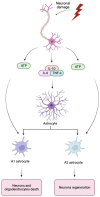Astroglial Cells: Emerging Therapeutic Targets in the Management of Traumatic Brain Injury
- PMID: 38247839
- PMCID: PMC10813911
- DOI: 10.3390/cells13020148
Astroglial Cells: Emerging Therapeutic Targets in the Management of Traumatic Brain Injury
Abstract
Traumatic Brain Injury (TBI) represents a significant health concern, necessitating advanced therapeutic interventions. This detailed review explores the critical roles of astrocytes, key cellular constituents of the central nervous system (CNS), in both the pathophysiology and possible rehabilitation of TBI. Following injury, astrocytes exhibit reactive transformations, differentiating into pro-inflammatory (A1) and neuroprotective (A2) phenotypes. This paper elucidates the interactions of astrocytes with neurons, their role in neuroinflammation, and the potential for their therapeutic exploitation. Emphasized strategies encompass the utilization of endocannabinoid and calcium signaling pathways, hormone-based treatments like 17β-estradiol, biological therapies employing anti-HBGB1 monoclonal antibodies, gene therapy targeting Connexin 43, and the innovative technique of astrocyte transplantation as a means to repair damaged neural tissues.
Keywords: astrocytes; astroglia; traumatic brain injury.
Conflict of interest statement
The authors declare no conflict of interest.
Figures



References
-
- Maas A.I.R., Menon D.K., David Adelson P.D., Andelic N., Bell M.J., Belli A., Bragge P., Brazinova A., Büki A., Chesnut R.M., et al. Traumatic Brain Injury: Integrated Approaches to Improve Prevention, Clinical Care, and Research. Lancet Neurol. 2017;16:987–1048. doi: 10.1016/S1474-4422(17)30371-X. - DOI - PubMed
Publication types
MeSH terms
Substances
LinkOut - more resources
Full Text Sources

